This is the second of a three-part series summarizing our sleeping arrangements and strategies for securing them over the course of our world bike tour. (Yes, I said two-part series last time, but the topic seems to keep growing as I write about it.) Last week, I showed this graph which gave a percentage breakdown of where we slept each of the 771 nights of our trip.
(For detailed explanations of each category, see last week’s Part 1 post here.)
So, in generalized categories, we spent roughly 30 percent of our time camping and 30 percent in hotels, The last 40 percent goes into hospitality, whether it was someone we knew before the trip, met during our travels, contacted through warmshowers, and anything in between.
I guess it all spreads out over the course of the journey, but while we were in the thick of it, it didn’t always feel as varied as it looks on the back end. That’s because each region we traveled through presented different circumstances and challenges to consider as far as sleeping arrangements. So we would like to share with you, our readers, and especially fellow cyclists, our strategies for each of the six regions in which we traveled.
Eastern United States
We launched our tour on home turf, thinking it would be a good idea to get a feel for life on the road without the additional strains of culture shock and language barriers. Looking back, we are grateful we made this decision. We rode in the Eastern U.S. from Maine to south Alabama, where I was in a wedding that fall. This part of our homeland turned out to be ideal for free camping. Each day, we would aim to end up in a small town, ideally fewer than 3,000 people. Upon arrival, we would scout out churches, town parks or fire departments that looked like they might have a spot we could pitch our tent for the night. We tried to get permission when we could, particularly for the fire departments and churches, being as they are more like private property. Often, the town park option would include a bathroom where we could rinse off our faces and arms, wash our dishes and scrub our clothes in the sink. And in many cases, we were able to camp under the covering of a pavilion—unbelievably convenient in the case of rain!
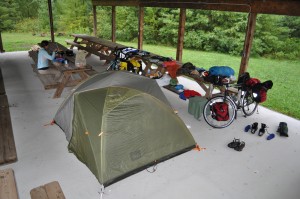
This particular pavilion was behind a church in Pennsylvania. It rained the whole night and next morning–but we packed up a dry tent! What luxury!
Altogether, our recommendation for this region is: ASK! If you can stop in a town, do it, and ask around. If there’s really not a good public property option, someone is likely to have mercy on you and allow you to camp in their lawn for the night. That happened to us several times—and often included a shower! We found that asking permission and camping in small towns was much easier than simply pulling off into the woods, as most of the forested lands are private property, and are either marked as so or fenced off.
Central America
While we loved our experience at language school in Guatemala, overall, Central America was not our favorite region for bike touring. A huge part of that was the shift in strategy for sleeping arrangements, and a few factors played into that. First of all, this region is HOT. Like, seriously mega hot. And it’s hard to motivate yourself to camp when you know you’ll be sleeping in a puddle of sweat. We got in a pattern of waking up at 4 a.m. most mornings and riding as hard as we could until we couldn’t bear the heat any longer—usually around noon! That was the second issue—you can’t really pull off the road and start looking for a stealthy free campsite at noon. Our strategy for Central America was to primarily stay in hotel rooms. Besides the previous two reasons I gave, we also felt it was worth the $10-15 it cost to sleep indoors with a fan and get a shower each night. And last of all, we simply felt safer with all our possessions inside. As a general rule, we did not feel unsafe traveling by bicycle over the course of our two-year journey. Though we had no major problems, Central America was the region in which we felt the least safe. So, for us, it was worth the small expense of a room to feel more secure with all our stuff inside while we slept soundly through the night. However, the farther south we went, the safer we felt, and we actually did camp a few times in Costa Rica and Panama. Rooms were also slightly more expensive in those countries, maybe more like $20 per night. So we tried to take advantage of the friendlier camping conditions.
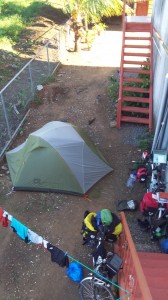
We literally camped right behind a motel in this small town in Costa Rica–with the owners’ permission of course!
South America
We felt South America had the best balance as far as sleeping arrangements go. Free camping was a breeze, and we usually selected places out in the rural areas, between towns. We could usually find some kind of tree or brush or hill or something to tuck our tent behind for the night. We would “disappear” from the visibility of the road, but usually were close enough that it was quick and easy to get back on our route in the morning. The Andean ranges we rode through provided beautiful scenery for our nights out under the stars. However, we were also able to rent a room two or three nights each week, and sometimes more. While we loved the rustic nature of camping, it was great to be able to take a shower, wash dishes in a sink and sleep in a bed the other nights. Rooms in South America have a broad range of prices, from $20-30 in Chile and Argentina (particularly in touristy areas), to $5-8 in Bolivia, Peru and Ecuador. It was great to not have the pressure of “needing” to free camp every night to save money, since rooms were inexpensive, but it was also great to enjoy the scenic free camping options. Like I said, it was, to us, the best balance of the two among all the regions in which we traveled.
Europe
Be ready to be shocked: we spent the least amount of money on accommodations in Europe. That’s right. Europe is easily the most expensive region in which we traveled, and yet, for us, we saved big time on our lodging expenses. How so? Free camping and warm showers. Our strategy for free camping was different than in the US—no longer did fences keep us out of the woods. We would aim on most days to end up somewhere between the towns listed on our map. Once we were out of a populated area, we would simply find a patch of forest—big or small—and stealthily slip in for the night. One exception to this was England, where we found ourselves speaking the native language and would often stop and ask at churches or fire departments, like we did back home.
Europe was the first place we mastered a good system for Warmshowers.org. For those of you who aren’t familiar, Warmshowers is a hospitality exchange network for touring cyclists. We had managed to schedule two or three hosting experiences in South America, which were awesome, but when we got to Europe, the floodgates opened. There are Warmshowers hosts in every major European city, and many more in the thousands of small towns in between. Our strategy for Europe was to free camp every night, and about once a week, stop for a rest day in an interesting place—and stay with a Warmshowers host for two nights. It was incredibly effective. In six months’ time, we paid for fewer than 10 hotel rooms, most of which were once we got into the Balkans in Eastern Europe and there weren’t as many Warmshower hosts available (and the hotels were significantly less expensive). In addition to free places to stay, we found ourselves being directed and even guided around historic cities by locals. We barely touched our guidebook. And on top of amazing hospitality and wonderful tourist information, we made friends… friends that we are still in touch with via e-mail and facebook… friends we hope to host in our home one day, or whom we hope to return and visit again in the future.
Southeast Asia
As we made our way to Asia, we hoped that it would offer a similar balance of camping and hotels as South America did. And for the first chunk of our time there, it was close. Our strategies changed a bit in Asia, as for the first time on our journey, we faced the language barrier. We had known Spanish for South and Central America, and English works sufficiently in Europe… but now we were in China. Fortunately, our friends who lived in China printed a list—in English and Chinese—of helpful phrases and words. One of them was, “We have a tent… can we use it here?” We used that one a few times. Also, we wised up and printed off a picture dictionary. We had seen this professional one for sale in a bookstore, but we picked the few things we needed, like a picture of a tent or a few of the foods we liked, and printed them ourselves for a fraction of the cost. This became an essential tool in communication for us, and played a big role in securing campsites many times. Throughout China, Vietnam and Laos, we spent about 40 percent of our time free camping, and about 60 percent in paid hotel rooms. China and Vietnam presented new challenges for free camping—almost every inch of unpopulated area was in agricultural use—and I can tell you, there’s just no pitching your tent in a rice paddy. But we learned to make it work, and often pointed to the picture of our tent, then pointed to the spot we wanted to pitch it… and we often found the small villages of people wanting to take us under their wing of protection for the night.
However, once we crossed from Laos to Cambodia, our camping in Asia was virtually done. First of all, Cambodia is known for having the most unexploded ordinance of any country in the world—and we decided that even though it was probably fine in the heavily traveled areas where we were, it was not worth taking the risk. Especially because rooms never cost more than $10 a night. And from Cambodia south, we stuck to the hotel regimen, as we worked our way into the hot season and temperatures skyrocketed. We camped once in Thailand, and vowed not to try again, after spending a mostly sleepless night longing for a breeze or a fan or ANYTHING to cool us off! Because hotels were inexpensive, we figured it was worth the $8-15 to get a decent night of sleep.
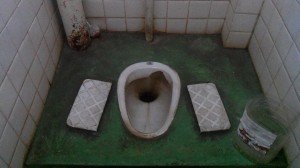
One of the “non” highlights of the Asian hotels was the bathroom situation. This squat toilet was in our last accommodation in Malaysia. Please bear in mind that we were always looking for the cheapest place in town!
Western United States
We returned to the U.S., planning to use the same approach to free camping we had used in the East. However, we didn’t take into account the different culture and issues of the West Coast. We learned quickly, though, as on our sixth night of free camping back in the homeland, we officially got “moved along” by the police from a free campsite in a town park. Whoops. What we realized is that in this part of the country, there were loads of people traveling by bicycle or backpacking… some as a permanent lifestyle, and others on a short-term trip like our own. Either way, we weren’t the only nomads looking for a place to sleep every night, and because of this issue, police were on the prowl. No more pulling off in town parks or church yards. So though it was challenging, we were usually able to find a patch of trees or somewhere we could “disappear” at the end of the day. We also camped in lots of state parks that offered “hiker-biker sites”—primitive campsites that were discounted if you arrived on foot or on a bicycle. Once we ventured away from the Pacific Coast and its vagabond populace, we found it easier to secure campsites. And once we got to Nevada and Utah, there was loads of public land where free camping was permitted, like National Forests or Bureau of Land Management areas.
Ultimately, we would divide the US into “Eastern US,” being east of the Rockies, and “Western US,” being west of the Rockies. Once we had crossed the Continental Divide and descended onto the plains of eastern Colorado and Kansas, we immediately resumed camping at town parks and churches without any issue at all.
So there you go–our strategies, broken down by region. Because this post grew progressively longer as I wrote, this has officially become a three-part series! Next week we will finish up some Q & A’s we started last week about some of our more interesting sleeping arrangements over the course of our journey. If you have a question you’d like us to answer, it’s not too late! Either post a comment, or e-mail it to garthsontour@gmail.com. We’ll be answering all those questions, as far as addressing a few more logistics from our trip, all in next week’s final “Where We Slept” post!

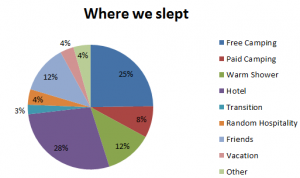
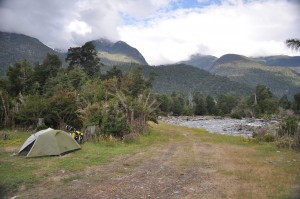
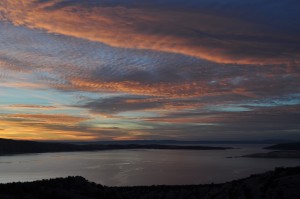
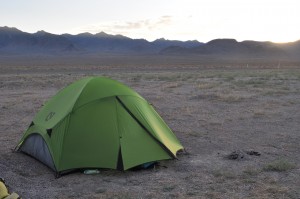
1 comment
Thomas says:
Dec 7, 2013
Very useful post (especially for us, when planning a tour !), great idea to divide it into Regions. Can’t wait for the next part !